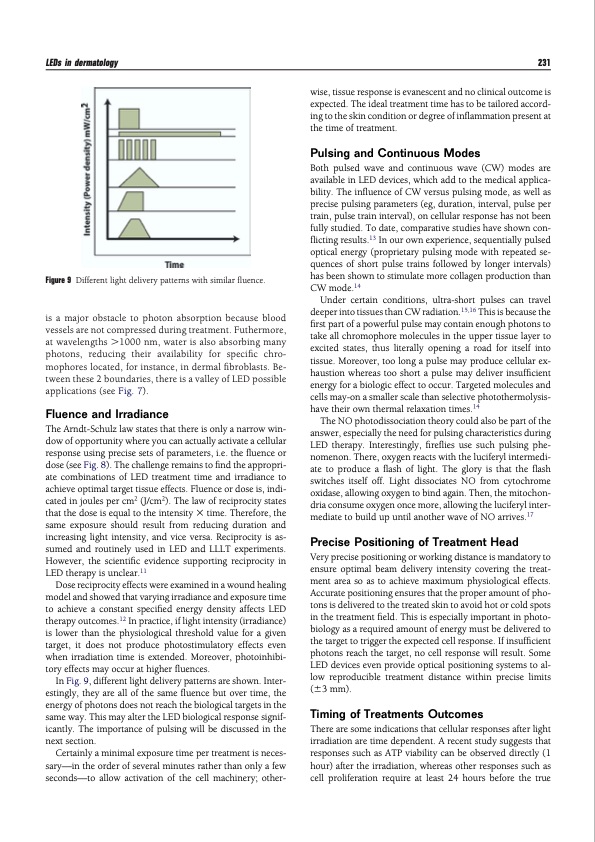
PDF Publication Title:
Text from PDF Page: 006
LEDs in dermatology 231 Figure 9 Different light delivery patterns with similar fluence. is a major obstacle to photon absorption because blood vessels are not compressed during treatment. Futhermore, at wavelengths 1000 nm, water is also absorbing many photons, reducing their availability for specific chro- mophores located, for instance, in dermal fibroblasts. Be- tween these 2 boundaries, there is a valley of LED possible applications (see Fig. 7). Fluence and Irradiance The Arndt-Schulz law states that there is only a narrow win- dow of opportunity where you can actually activate a cellular response using precise sets of parameters, i.e. the fluence or dose (see Fig. 8). The challenge remains to find the appropri- ate combinations of LED treatment time and irradiance to achieve optimal target tissue effects. Fluence or dose is, indi- cated in joules per cm2 (J/cm2). The law of reciprocity states that the dose is equal to the intensity time. Therefore, the same exposure should result from reducing duration and increasing light intensity, and vice versa. Reciprocity is as- sumed and routinely used in LED and LLLT experiments. However, the scientific evidence supporting reciprocity in LED therapy is unclear.11 Dose reciprocity effects were examined in a wound healing model and showed that varying irradiance and exposure time to achieve a constant specified energy density affects LED therapy outcomes.12 In practice, if light intensity (irradiance) is lower than the physiological threshold value for a given target, it does not produce photostimulatory effects even when irradiation time is extended. Moreover, photoinhibi- tory effects may occur at higher fluences. In Fig. 9, different light delivery patterns are shown. Inter- estingly, they are all of the same fluence but over time, the energy of photons does not reach the biological targets in the same way. This may alter the LED biological response signif- icantly. The importance of pulsing will be discussed in the next section. Certainly a minimal exposure time per treatment is neces- sary—in the order of several minutes rather than only a few seconds—to allow activation of the cell machinery; other- wise, tissue response is evanescent and no clinical outcome is expected. The ideal treatment time has to be tailored accord- ing to the skin condition or degree of inflammation present at the time of treatment. Pulsing and Continuous Modes Both pulsed wave and continuous wave (CW) modes are available in LED devices, which add to the medical applica- bility. The influence of CW versus pulsing mode, as well as precise pulsing parameters (eg, duration, interval, pulse per train, pulse train interval), on cellular response has not been fully studied. To date, comparative studies have shown con- flicting results.13 In our own experience, sequentially pulsed optical energy (proprietary pulsing mode with repeated se- quences of short pulse trains followed by longer intervals) has been shown to stimulate more collagen production than CW mode.14 Under certain conditions, ultra-short pulses can travel deeper into tissues than CW radiation.15,16 This is because the first part of a powerful pulse may contain enough photons to take all chromophore molecules in the upper tissue layer to excited states, thus literally opening a road for itself into tissue. Moreover, too long a pulse may produce cellular ex- haustion whereas too short a pulse may deliver insufficient energy for a biologic effect to occur. Targeted molecules and cells may-on a smaller scale than selective photothermolysis- have their own thermal relaxation times.14 The NO photodissociation theory could also be part of the answer, especially the need for pulsing characteristics during LED therapy. Interestingly, fireflies use such pulsing phe- nomenon. There, oxygen reacts with the luciferyl intermedi- ate to produce a flash of light. The glory is that the flash switches itself off. Light dissociates NO from cytochrome oxidase, allowing oxygen to bind again. Then, the mitochon- dria consume oxygen once more, allowing the luciferyl inter- mediate to build up until another wave of NO arrives.17 Precise Positioning of Treatment Head Very precise positioning or working distance is mandatory to ensure optimal beam delivery intensity covering the treat- ment area so as to achieve maximum physiological effects. Accurate positioning ensures that the proper amount of pho- tons is delivered to the treated skin to avoid hot or cold spots in the treatment field. This is especially important in photo- biology as a required amount of energy must be delivered to the target to trigger the expected cell response. If insufficient photons reach the target, no cell response will result. Some LED devices even provide optical positioning systems to al- low reproducible treatment distance within precise limits (3 mm). Timing of Treatments Outcomes There are some indications that cellular responses after light irradiation are time dependent. A recent study suggests that responses such as ATP viability can be observed directly (1 hour) after the irradiation, whereas other responses such as cell proliferation require at least 24 hours before the truePDF Image | Light-Emitting Diodes (LEDs) in Dermatology

PDF Search Title:
Light-Emitting Diodes (LEDs) in DermatologyOriginal File Name Searched:
led-dermatology.pdfDIY PDF Search: Google It | Yahoo | Bing
Cruise Ship Reviews | Luxury Resort | Jet | Yacht | and Travel Tech More Info
Cruising Review Topics and Articles More Info
Software based on Filemaker for the travel industry More Info
The Burgenstock Resort: Reviews on CruisingReview website... More Info
Resort Reviews: World Class resorts... More Info
The Riffelalp Resort: Reviews on CruisingReview website... More Info
| CONTACT TEL: 608-238-6001 Email: greg@cruisingreview.com | RSS | AMP |